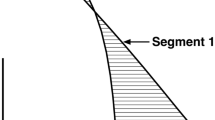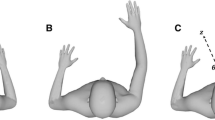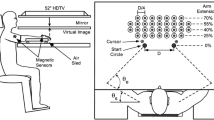Abstract
Despite the importance of proprioception during upper limb movement, the extent to which arm/hemisphere asymmetries exist in the utilization of proprioceptive feedback remains unclear. In the present study, movement accuracy and arm dynamics were examined in 20 right-handed adults during a proprioceptive matching task that required subjects to actively match remembered target positions of the elbow with the contralateral arm. As hypothesized, the results indicated an accuracy advantage in favor of the non-preferred left arm reflected by smaller absolute matching errors when compared to the preferred right arm. This advantage was most pronounced for larger amplitude movements and was not associated with any limb-specific difference in movement strategy as indicated by the dynamics of the matching movement. These results extend current theories of handedness by demonstrating that, in right-handed individuals, the non-preferred arm/hemisphere system is more adept at utilizing position-related proprioceptive information than the preferred arm/hemisphere system.


Similar content being viewed by others
References
Annett J, Annett M, Hudson PT, Turner A (1979) The control of movement in the preferred and non-preferred hands. Q J Exp Psychol 31:641–652
Bagesteiro LB, Sainburg RL (2003) Nondominant arm advantages in load compensation during rapid elbow joint movements. J Neurophysiol 90:1503–1513
Carnahan H, Elliott D (1987) Pedal asymmetry in the reproduction of spatial locations. Cortex 23:157–159
Carson RG, Elliott D, Goodman D, Dickinson J (1990) Manual asymmetries in the reproduction of a 3-dimensional spatial location. Neuropsychologia 28:99–103
Carson RG, Goodman D, Chua R, Elliott D (1993) Asymmetries in the regulation of visually guided aiming. J Mot Behav 25:21–32
Chapman CD, Heath MD, Westwood DA, Roy EA (2001) Memory for kinesthetically defined target location: evidence for manual asymmetries. Brain Cogn 46:62–66
Colley A (1984) Spatial location judgements by right and left-handers. Cortex 20:47–53
Cordo P, Carlton L, Bevan L, Carlton M, Kerr GK (1994) Proprioceptive coordination of movement sequences: role of velocity and position information. J Neurophysiol 71:1848–1861
Elliott D, Weeks DJ, Jones R (1986) Lateral asymmetries in finger-tapping by adolescents and young adults with Down syndrome. Am J Ment Defic 90:472–475
Elliott D, Heath M, Binsted G, Ricker KL, Roy EA, Chua R (1999) Goal-directed aiming: correcting a force-specification error with the right and left hands. J Mot Behav 31:309–324
Flowers K (1975) Handedness and controlled movement. Br J Psychol 66:39–52
Goble DJ, Lewis CA, Hurvitz EA, Brown SH (2005) Development of upper limb proprioceptive accuracy in children and adolescents. Hum Mov Sci 24:155–170
Haaland KY, Harrington D (1989a) The role of the hemispheres in closed loop movements. Brain Cogn 9:158–180
Haaland KY, Harrington DL (1989b) Hemispheric control of the initial and corrective components of aiming movements. Neuropsychologia 27:961–969
Kawato M (1999) Internal models for motor control and trajectory planning. Curr Opin Neurobiol 9:718–727
Lonn J, Crenshaw AG, Djupsjobacka M, Pedersen J, Johansson H (2000) Position sense testing: influence of starting position and type of displacement. Arch Phys Med Rehabil 81:592–597
Mieschke PE, Elliott D, Helsen WF, Carson RG, Coull JA (2001) Manual asymmetries in the preparation and control of goal-directed movements. Brain Cogn 45:129–140
Mima T, Sadato N, Yazawa S, Hanakawa T, Fukuyama H, Yonekura Y, Shibasaki H (1999) Brain structures related to active and passive finger movements in man. Brain 122(Pt 10):1989–1997
Oldfield RC (1971) The assessment and analysis of handedness: the Edinburgh inventory. Neuropsychologia 9:97–113
Roy EA, MacKenzie C (1978) Handedness effects in kinesthetic spatial location judgements. Cortex 14:250–258
Roy EA, Kalbfleisch L, Elliott D (1994) Kinematic analyses of manual asymmetries in visual aiming movements. Brain Cogn 24:289–295
Sainburg RL (2002) Evidence for a dynamic-dominance hypothesis of handedness. Exp Brain Res 142:241–258
Sainburg RL, Ghilardi MF, Poizner H, Ghez C (1995) Control of limb dynamics in normal subjects and patients without proprioception. J Neurophysiol 73:820–835
Taylor HG, Heilman KM (1980) Left-hemisphere motor dominance in righthanders. Cortex 16:587–603
Wang J, Sainburg RL (2003) Mechanisms underlying interlimb transfer of visuomotor rotations. Exp Brain Res 149:520–526
Wang J, Sainburg RL (2004) Limitations in interlimb transfer of visuomotor rotations. Exp Brain Res 155:1–8
Winstein CJ, Pohl PS (1995) Effects of unilateral brain damage on the control of goal-directed hand movements. Exp Brain Res 105:163–174
Acknowledgements
Special thanks to J. Chesney for his assistance with the data collection and analysis aspects of this project.
Author information
Authors and Affiliations
Corresponding author
Rights and permissions
About this article
Cite this article
Goble, D.J., Lewis, C.A. & Brown, S.H. Upper limb asymmetries in the utilization of proprioceptive feedback. Exp Brain Res 168, 307–311 (2006). https://doi.org/10.1007/s00221-005-0280-y
Received:
Accepted:
Published:
Issue Date:
DOI: https://doi.org/10.1007/s00221-005-0280-y




